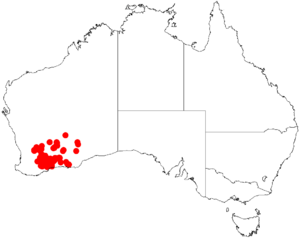Acacia uncinella facts for kids
Quick facts for kids Acacia uncinella |
|
|---|---|
| Scientific classification | |
| Genus: |
Acacia
|
| Species: |
uncinella
|
 |
|
| Occurrence data from AVH | |
Acacia uncinella is a type of shrub that belongs to the Acacia plant family. It's special because it's found only in a specific part of southwestern Australia. This plant is also known as a "wattle" in Australia.
What Does Acacia uncinella Look Like?
This round-shaped shrub usually grows to be about 0.3 to 3 metres (1 to 10 ft) tall. Its branches are round and can be smooth or slightly hairy.
Like most Acacia plants, it doesn't have regular leaves. Instead, it has special leaf-like parts called phyllodes. These phyllodes are always green and can be straight or a little bit curved. They are about 1 to 3.5 cm (0.39 to 1.38 in) long and 0.7 to 1.5 mm (0.028 to 0.059 in) wide. Each phyllode has eight raised lines, like tiny veins.
Flowers and Seed Pods
Acacia uncinella blooms from August to October, showing off its yellow flowers. The flowers grow in small, round clusters, about 2.8 to 4.5 mm (0.11 to 0.18 in) across. Each cluster has 16 to 30 golden-colored flowers. These flower clusters grow in pairs where the phyllodes meet the stem.
After the flowers bloom, thin, smooth seed pods start to form. These pods are long and narrow, about 4 to 5 cm (1.6 to 2.0 in) long and 2.5 to 3.5 mm (0.098 to 0.138 in) wide. They look a bit bumpy because they are slightly raised over each seed inside. The seeds themselves are shiny and blackish with mottled spots. They are oval-shaped and about 2.5 to 3.5 mm (0.098 to 0.138 in) long. Each seed has a small, crest-like attachment called an aril.
Where Does Acacia uncinella Grow?
This plant is native to the Wheatbelt and Goldfields-Esperance areas of Western Australia. It often grows near salt flats and lakes, or on slopes and sandy plains. You can find it in rocky, loamy, or sandy soils.
It's spread out across the region. Most of the plants are found from Ongerup in the west, all the way to the Wittenoom Hills (about 50 km (31 mi) north of Esperance) in the east. It also grows as far north as Hyden.
Other smaller groups of Acacia uncinella can be found around Merredin, Kellerberrin, and Boorabbin National Park. You can also spot it south of Zanthus. It often grows alongside other plants like Banksia and Casuarina shrubs, and in Eucalyptus woodlands.

